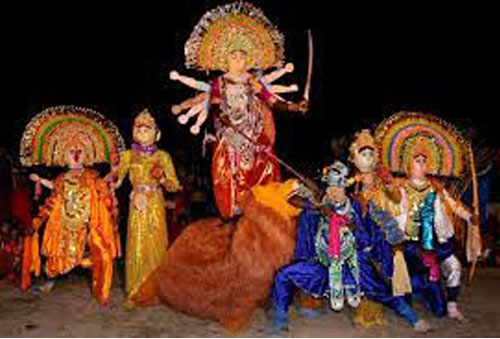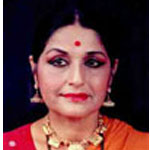The Mayurbhanj Chhau
Mayurbhanj Chhau originated in Orissa (now Odisha). This was once a state and adjacent to it were the states of Saraikela and Purulia, the former today a part of Bihar, and the latter a part of West Bengal. The entire composite area where all the three Chhau traditions belong is teeming with a large number of tribes. Many of these tribes are agriculturists or cultivators, and are bound by rituals which symbolise veneration of fertility.
The Mayurbhanj Chhau, though reflecting village culture, also exhibits very strong influence of tribal elements as well. This dance is traditionally performed close to Dussehra and also to celebrate the Chaitra Parva.
A very distinctive feature of this dance is that the gurus are called ‘Ustaads’. It is very obvious that at some point in time this term, which belongs to the Urdu tradition, came to be adopted in the Mayurbhanj Chhau terminology. The ‘Ustaads’ and musicians offer prayers at a temple dedicated to Lord Bhairava as a preliminary ritual before starting the actual Chaitra Parva. At this propitiatory ceremony, new dancers are ritually initiated. There are other rituals also that have to be performed. There is the worship of a pitcher which is called the nishighata (the night pitcher) also called ‘kaamanaa’ or desire, which is supposed to represent Shakti (the female energy). There is also a ritual of offering scented sweet drink called ‘pana’ to the Sun god to propitiate him and seek his protection. All these rituals clearly have their deep roots in the Hindu philosophy from times immemorial and have deep symbolic meaning. It is apparent that the totality of Chhau as an institution was meant to achieve religious, social and cultural integration by encompassing different streams of Hindu religion.
In the growth of this stream of Chhau, it is evident that the technique of ancient warfare, in the form of martial practices, has played a very important role. This tradition has embraced the tribal dances which collectively morphed into Chhau. Like the Saraikela stream, the Mayurbhanj also received royal patronage. Chhau was well suited for an important three-pronged purpose – perpetuating an art, retaining and nurturing the royal tradition of martial practices, and bringing about the integration of the princely culture with tribal culture.
Evolution and growth
In the initial stages of its development, the Chhau was limited to the performance of Rookmaar naach, which means ‘the dance of mock fight’. As the system developed, many more themes with a special emphasis on heroic deeds were added to the repertoire. Thus, the stories from the Ramayana and Mahabharata, the Puraanas and the Bhagawata, came to be enacted together with Shiva, Parvati, Krishna, Vishnu and other gods and demi-gods from the Hindu pantheon. This development towards portrayal of characters and enactment of dramatic themes very naturally ushered in a more polished level of stylisation. During the later stages of development, to bring in uniformity, the Saraikela Chhau started using masks for every character, whereas the Mayurbhanj Chhau totally discarded the mask.
Without the mask, the Mayurbhanj stream adopted a high level of stylisation in the performance technique which retained extreme virility of the original martial practices. This resulted in excellence in choreography, specially of groups. In Mayurbhanj Chhau, it is the movement alone that becomes visual poetry, a poem that is redolent with nature and her manifestations like storms, rivers, lagoons and the sun.
The technique of Mayurbhanj Chhau, though quite distinctive, has certain similarities with that of Saraikela. But in Mayurbhanj the movements are broadly divided in three groups, each with its own specific mood: Hatiaardhara- (holding of weapons), Kalibhanga (bending of a bud) and Kalikaata (cutting the tender sprig). Like the other Chhau streams, uflis and topkas make up the dance patterns. Totally, there are 36 uflis; of special beauty are the uflis that are inspired by the daily chores of a housewife. These are unparalleled and their equivalent is not to be found in other dance traditions. These uflis reveal the rhythm and the charm hidden in even the mundane activities of a housewife.
There are three types of dance in the Mayurbhanj Chhau: Phoot naacha (solo dance), Jodi naacha (duet dance) and Mela naacha (group dance). Each dance presentation has three successive stages as progression:
Rangabaajaa: Play of music which takes place behind the screen and cannot be seen by the audience. It prepares the dancer to achieve the mood of the dance, making him forget the corporal, worldly surroundings.
Chaali: After Rangabaajaa, the orchestra plays the basic tune of the dance. Here, after the curtain rises, the different characters come down the stage into the centre of the dancing space in a very stylised way of walking called Chaali.
Naacha: The thematic content of the dance is developed and the drama is built up.

Naatki: A fast tempo is built up with great vigour. This stage is characterised by fast paced movements with intricate choreographic patterns.
Due to this extreme vigorous dancing, it is thought that they are totally unsuitable or out of the reach of women and thus the female characters are essayed by men only. The music for Mayurbhanj Chhau is mainly inspired by the folk songs of the region. Of late, Hindustani ragas are also incorporated. The tunes are played on the Mahori, which is a wind instrument resembling shehnai. The rhythm is provided by the percussion instruments like dhol, chadchadi, tikra, and the dhumsa.
The Purulia Chhau
Mayurbhanj Chhau of Orissa and Saraikela Chhau of Bihar represent a relationship that arises out of a common tradition of dance, which has its roots in martial practices. Yet another facet of this tradition is Purulia Chhau of West Bengal. It exhibits facets of the other two traditions – it embodies the vigour of martial grandeur, and an epic style of performance which is akin to that of Mayurbhanj Chhau; at the same time, like Saraikela Chhau, it is a masked dance presentation.
Unlike Saraikela Chhau, Purulia is not performed by the princes. On the contrary, it appears to be the preserve of what is termed as socio-economically backward classes. But today it is this class of people who are repositories of a tradition of dance and music which is highly developed and rich in its content. From the outside this tradition appears to be popular art, but when it is studied in-depth, it is beautifully structured with a highly sophisticated form.
The geographical area from which Purulia Chhau hails is inhabited with many scheduled castes and tribes, whose cultural ethos exhibit overlaying of faiths and beliefs of their tribal ancestors by the later Hindu emergence of the Vaishnava sect.
Like Mayurbhanj and Saraikela Chhau, Purulia Chhau is also an open-air performance. There is a 20 feet by 20 feet area in the open ground, which can best be described as the stage in the modern parlance. The audience sits on three sides of the area. The musicians sit together on one side. The performance begins at night by 10 p.m. There are, like in the other two, pre-performance rituals to be performed.
The performance begins with the entry of the orchestra. Then enters a dancer who wears the mask of Ganesha. The entry of Ganesha signals the beginning of the dramatic episode. Then on, the story moves forward swiftly with quick entries and exits of other characters. The stances and the stylised walk employed by the actors are similar to the other two Chhaus. Earlier, lighting was provided by mobile lightmen bearing flaming torches on their heads; now they use petromax lights which lessens the dramatic impact.

The music variety is rather limited. Connection with Hindustani music is negligible. The dance is always accompanied by a wind instrument which resembles the shehnai. The percussion instruments – the dhol and the dhumsa are almost similar to Mayurbhanj Chhau. The taala cycles are very complex and unlike any other known systems.
The dance technique of Purulia Chhau exhibits some similarities with the other two Chhau streams. There are some specific individualities also. The animals crawl on all fours, the birds leap and jump. All parts of the body are effectively used. There is the walk on knees and pirouetting on the knees. At the same time, certain uflis and topkas of the other two can also be discerned. Certain movements are very forceful, representing attack and defence of the martial tradition. Really breathtaking are the leaps and jumps where the actor/dancer lands on the ground on his knees, which is the unique feature of this dance-drama style. The extensive use of the torso and expressive use of the lower limbs are different from those of the other two Chhaus. Purulia Chhau exudes dynamism.
The mask
No discussion on Purulia Chhau can be complete and comprehensive without mentioning the most distinctive quality of the masks. The Saraikela masks are highly refined, smooth and stylised and courtly in their effect. The eyes are expressive but never drawn realistically.
In Purulia, the same characters create totally different effects. They represent very vital, aggressive beings, raw masculinity, without any delicacy or lyricism, yet they are strangely realistic.
Unique to Purulia Chhau are the masks for birds and animals which completely mask the entire body. The birds are shown with a pair of wings, a head and face mask and costume which represents the body of the bird. In Saraikela the masks are made of wood, whereas in Purulia they are made from the mud collected from streams and rivers.


 [/column]
[/column]